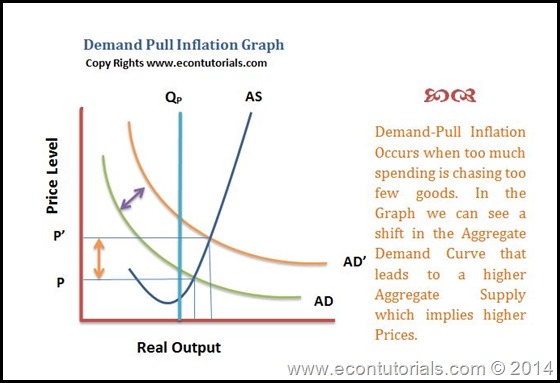In all of our lectures we have been discussing how an increase or decrease in Supply or Demand For money consequently increase or decrease Inflation. In this lecture, we emphasize on important modern inflationary theories that is Demand Pull inflation and Cost Push Inflation. Both of these are associated with Keynesian Economics.
Demand Pull Inflation
Every Economy has a certain level of potential capacity of producing something and cannot produce more than that capacity.
Demand-Pull inflation arises when the aggregate demand increases more than the economy’s potential for productivity which leads to rise in Prices so as to have have a new new equilibrium with the Aggregate Supply.
As I explained that further production for an economy is not possible so an increase in the aggregate demand would only increase the price of the available products and not the Production level. IN other words when Aggregate Demand for goods and Services increase, individuals bid over the limited quantities available. Hence, the price of the available products and Services Increases. Additionally, Employment level falls and wages rises that increases the inflationary process rapidly.
Factors that Generate Demand-Pull inflation
There are various factors that can give rise to Aggregate Demand. One of the common factors are:
- Consumption
- Investment
- Government Spending
One general example can be taken when there are economies which tend to increase their Government Spending and are than dependent over the monetary institutions to Print more money to offset their deficit that as a result Increases the Aggregate Demand.
Graphical Explanation of Demand-Pull Inflation
Cost-Push Inflation/Supply Shock Inflation/Stagflation
There are not only increases in Price levels because of Demand but also because of Costs.
Increase in the Price Level due to a rise in the costs that as a result pushes up the Aggregate Supply is called Supply-Shock Inflation or Cost-Push Inflation.
This process further more leads to an economic slowdown called “Stagflation”.
Stagflation is a situation in which the inflation and unemployment rates are high and productivity levels fall.
With reference to the book of Samuelson Nordhaus “ It can lead to a Policy Dilemma of Stagflation when output declines at the same time when inflation is increasing”.
Policies used to curb Stagflation
Both Monetary and Fiscal Policy can be used to get rid of Stagflation but by using only one instrument that is AGGREGATE DEMAND. However, a shift in the Aggregate Demand either through consumption, investment or Government Expenditure cannot simultaneously increase the output and lower the price levels. In fact, by using such monetary expansion (increasing money supply in economy) would increase the output level but increase the price level even more.
It will also be a failed choice if monetary policy is tightened (contracting money supply from economy) because that will lower the Output levels even more. So in such a situation, policy makers argue that only one factor can be saved, either Price level or the Output by the use of only one instrument, Aggregate Demand.
Such are the complexities of running an economy….




I have been browsing online greater than 3 hours lately, yet I never found any interesting article like yours. It is lovely price enough for me. In my view, if all site owners and bloggers made good content material as you probably did, the web will be a lot more helpful than ever before.
Hi, just required you to know I he added your site to my Google bookmarks due to your layout. But seriously, I believe your internet site has 1 in the freshest theme I??ve came across. It extremely helps make reading your blog significantly easier.
Great post! I really enjoyed reading this. You explained the topic clearly and included some helpful insights. Looking forward to more content like this—keep up the awesome work!
outer banks merch
I just like the valuable info you supply to your articles. I will bookmark your blog and test again here frequently. I’m reasonably certain I will be told plenty of new stuff proper here! Good luck for the next!
Some really nice and useful information on this web site, likewise I think the style and design contains great features.
I believe this site contains some very fantastic info for everyone :D. “Morality, like art, means a drawing a line someplace.” by Oscar Wilde.
Excellent website. Lots of useful information here. I’m sending it to a few friends ans also sharing in delicious. And of course, thanks for your effort!
Thank you for another informative site. The place else may I am getting that type of info written in such a perfect means? I’ve a project that I’m just now working on, and I have been on the look out for such info.
We stumbled over here by a different page and thought I might as well check things out. I like what I see so i am just following you. Look forward to finding out about your web page for a second time.
Definitely, what a splendid blog and enlightening posts, I definitely will bookmark your blog.All the Best!
It is in reality a great and helpful piece of info. I am satisfied that you shared this useful information with us. Please keep us up to date like this. Thanks for sharing.
I carry on listening to the news bulletin talk about receiving boundless online grant applications so I have been looking around for the most excellent site to get one. Could you advise me please, where could i get some?
It’s actually a great and helpful piece of info. I am satisfied that you shared this useful info with us. Please stay us informed like this. Thank you for sharing.
I really like your writing style, fantastic info, thank you for putting up :D. “I hate mankind, for I think myself one of the best of them, and I know how bad I am.” by Joseph Baretti.
Dead written written content, Really enjoyed reading.
I am really loving the theme/design of your website. Do you ever run into any browser compatibility problems? A small number of my blog audience have complained about my blog not operating correctly in Explorer but looks great in Chrome. Do you have any ideas to help fix this issue?
Howdy! I know this is kinda off topic but I was wondering if you knew where I could get a captcha plugin for my comment form? I’m using the same blog platform as yours and I’m having difficulty finding one? Thanks a lot!
Well I really enjoyed studying it. This article procured by you is very practical for good planning.
Nice blog! Is your theme custom made or did you download it from somewhere? A theme like yours with a few simple adjustements would really make my blog stand out. Please let me know where you got your design. Bless you
You have observed very interesting details! ps nice internet site. “To grow mature is to separate more distinctly, to connect more closely.” by Hugo Von Hofmannsthal.
I truly enjoy studying on this internet site, it holds great articles.
I am no longer sure the place you are getting your information, but great topic. I must spend a while studying much more or working out more. Thanks for fantastic information I used to be looking for this information for my mission.
I simply couldn’t depart your site prior to suggesting that I extremely loved the usual information a person provide in your guests? Is gonna be again steadily to inspect new posts.
I truly enjoy studying on this site, it has got good articles. “The living is a species of the dead and not a very attractive one.” by Friedrich Wilhelm Nietzsche.
Pretty section of content. I just stumbled upon your blog and in accession capital to assert that I acquire actually enjoyed account your blog posts. Any way I will be subscribing to your feeds and even I achievement you access consistently fast.
There are definitely numerous particulars like that to take into consideration. That is a nice point to bring up. I supply the ideas above as common inspiration but clearly there are questions just like the one you carry up the place an important factor will probably be working in honest good faith. I don?t know if greatest practices have emerged round things like that, however I’m certain that your job is clearly identified as a good game. Both boys and girls really feel the influence of only a moment’s pleasure, for the rest of their lives.
I?¦ve recently started a website, the information you provide on this website has helped me greatly. Thanks for all of your time & work.
Some genuinely prime posts on this web site, bookmarked.
F*ckin’ remarkable things here. I am very happy to see your post. Thank you a lot and i am having a look forward to contact you. Will you kindly drop me a mail?
I couldn’t resist commenting
WONDERFUL Post.thanks for share..more wait .. …
great post.Ne’er knew this, thankyou for letting me know.
Very fantastic information can be found on web blog.
I like the valuable info you provide in your articles. I’ll bookmark your blog and check again here frequently. I am quite sure I’ll learn a lot of new stuff right here! Good luck for the next!
Hi, I think your site might be having browser compatibility issues. When I look at your website in Safari, it looks fine but when opening in Internet Explorer, it has some overlapping. I just wanted to give you a quick heads up! Other then that, fantastic blog!
Whats up very nice web site!! Guy .. Excellent .. Wonderful .. I will bookmark your site and take the feeds also…I’m satisfied to seek out a lot of useful info right here within the submit, we need work out more strategies in this regard, thanks for sharing.
Thanks for some other excellent article. Where else may anyone get that type of information in such a perfect method of writing? I have a presentation subsequent week, and I’m at the look for such information.
Hi, just required you to know I he added your site to my Google bookmarks due to your layout. But seriously, I believe your internet site has 1 in the freshest theme I??ve came across. It extremely helps make reading your blog significantly easier.